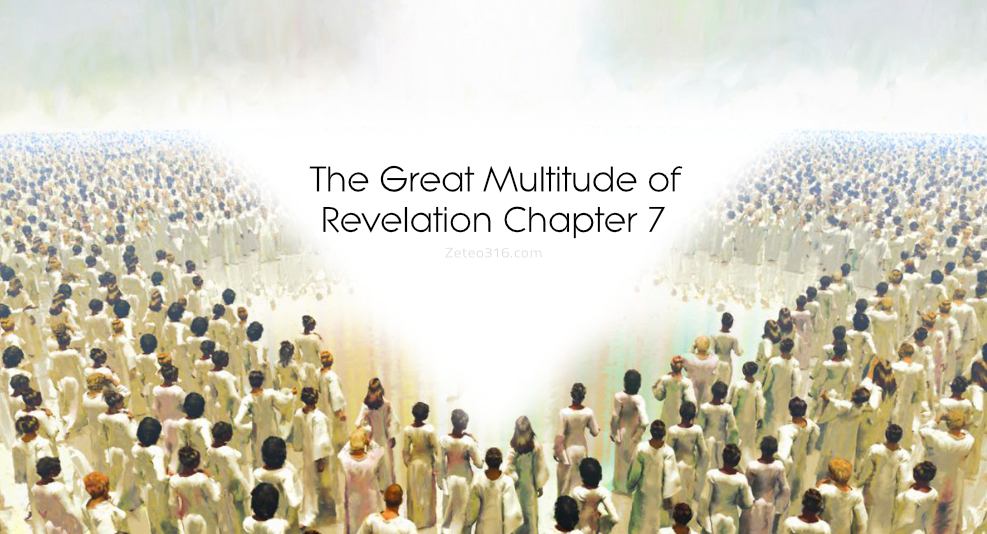
Who are the Great Multitude of Revelation chapter 7:9-17? There are different interpretations of this heavenly group depending upon one’s eschatology. Even among premillennialists.
Proponents of Covenant Theology often conflate the Great Multitude with the 144,000, mentioned earlier in chapter 7. An example of this is Brian Tabb’s Commentary (All Things New). Tabb sees this number as symbolic. After doing some subjective math comparing the number with the geometric dimensions of the New Jerusalem, he concludes that the 144, 000 and the Great Multitude are complimentary pictures of the same reality.
Historic Premillennialist George Ladd took a similar view (as noted in a previous article). According to him:
These twelve tribes cannot be literal Israel, because they are not the twelve tribes of OT Israel. The list here appears nowhere else in the Bible. It has three irregularities… The twelve tribes were irregularly listed to show that true Israel is not literal Israel, but the Church.
For a response to Ladd see Tony Garland’s commentary on Revelation 7. It is less forced to see these two groups as distinct. See Tony’s commentary on Interpreting Symbols.
Where premillennialist accept the difference between the two groups there are differing opinions regarding the nature of the arrival of the Great Multitude.
I recall pressing someone to defend his belief that the Great Tribulation will be cut shorter than the allotted three-and-a-half years (per Matt 24:22) and that Matt 24:31 was the rapture of the church. His response was to point me to Rev 7:9-17. This person integrated these three (allegedly connected) verses into an assumed cohesive whole to support his view. Yet each of these three verses can be validly (and perhaps better) interpreted in a different way to support a pretrib model.
More recently another proponent of the above view asserted that posttribbers and pretribbers cannot demonstrate the resurrection in Revelation. He dismisses Rev 4:1 (I agree) and also Rev 19:11-14. He’d no doubt also appeal to the above three verses, among others
However he assumes the post Rev 19 resurrection at Rev 20:4 (the only place where one is mentioned) is connected to the rapture which he envisions as occurring between the 6th and 7th seals. Hence it is further presumed that the arrival of the Great Multitude is a single-rapture-of-the-church event.
One problem is this…
The gathering of the Matt 24:31 elect occurs after the Great Tribulation, after the cosmic signs etc, after the appearance of the sign of the Son of Man, the mourning of the tribes and the coming in the clouds (Matt 24:29-31). It cannot then be said that the Great Multitude come out of (from within) the GT.
These are the ones who come out of the great tribulation, and washed their robes and made them white in the blood of the Lamb. Rev 7:14
Some scholars hold that the response to John form the elder indicates that the number of the Great Multitude is constantly being added to (not a one-time event). For example, according to A. T. Robertson:
They which come out of the great tribulation (oi ercomenoi ek th qlipsew th megalh). Present middle participle with the idea of continued repetition. “The martyrs are still arriving from the scene of the great tribulation” (Charles).
In his Commentary on Revelation, Buist Fanning writes of Rev 7:14 (page 271):
…these Christians from various ethnic backgrounds fall victim to natural deaths or to martyrdom for their faith. The Greek present tense participle (oi ercomenoi ek) used in the phrase “the ones who come out of the great tribulation” more naturally carries a distributive sense (repetition consisting of various individual acts viewed together; e.g., Rev 14:3, “the dead who die in the Lord”).
Robert Duncan Culver (Systematic Theology) also identifies the group of Rev 7:9-17 as among the righteous dead in heaven (pages 1042, 1043). He notes a similarity with the 5th seal group (Rev 6:9-11), but makes no mention of a resurrection-rapture connection to the Great Multitude.
When discussing the Greek grammar in Rev 7:14, more knowledgeable people sometimes appeal to “context.” When it comes to eschatology I suspect a person’s “context” is sometimes back-loaded with a predisposition to a particular view. In the above case, knowledgeable people do hold that the grammar implies a continual adding to the Great Multitude.
Much has also been said regarding the state of the Great Multitude. Are they in their glorified bodies? Those who affirm that these are, draw attention to the GM’s white robes and palms. Consequently in The Pre-Wrath Rapture of the Church (page 184), Marvin Rosenthal asserts that the former group [5th seal martyrs] are souls – while the latter group [Great Multitude] have bodies.
First of all if the 5th seal martyrs wear white robes, just as the Great Multitude do, there’s no reason why they couldn’t hold palms as well. Secondly, this position assumes properties of the intermediate-state body which aren’t elaborated on in Scripture.
Does the wearing of a white robe require a physical-resurrected body? For further thoughts on this point see Tony Garland’s commentary on Revelation 7:9.
In summary, I think there’s good evidence that the Great Multitude comprises of saints (believers) who have been slain during the Great Tribulation; that this group is being continually added to at the time of John’s discussion with the Elder; and that it is not connected to the gathering of the elect of Matt 24:31.
Finally, regardless of the nature of the arrival of this Great Multitude, incredible promises ought to give us great hope and comfort:
They shall neither hunger anymore nor thirst anymore; the sun shall not strike them, nor any heat; for the Lamb who is in the midst of the throne will shepherd them and lead them to living fountains of waters. And God will wipe away every tear from their eyes. Rev 7:16-17
Maranatha!
